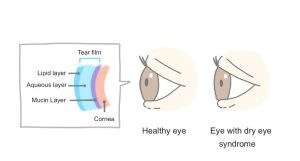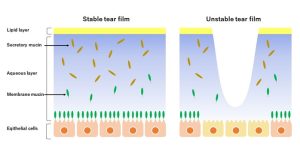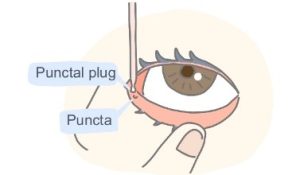If you feel that your eyes are dry or are suffering from fatigue, it’s important to see an ophthalmologist. However, there are things that can be addressed and improved in daily life to prevent dry eye or prevent it from getting worse.
Let’s review our daily habits.
Consciously blink more
Concentrating on a smartphone or computer screen not only reduces the number of blinks, and it is also often said that you’re not closing your eyes properly. It is important to consciously close your eyes and encourage tears to flow. Also, as a guide, take your eyes away from the screen for about 2 to 3 minutes out of every 30 minutes, or do other work, to ensure that your eyes are well rested.
Place screen below eye level
When the line of sight is directed upwards, tears tend to dry out as they tend to evaporate more easily. With your eyes facing down, you will avoid excessive eye opening, so adjust the height of your screen to prevent tear evaporation.
Make settings more pleasant to the eye
A computer or smartphone display that is too bright or has a small character size can overly strain your eyes. Adjust the text to an appropriate brightness setting and increase the size of the font to make it easier to read without squinting.
Use a humidifier
To prevent the eyes from drying out due to dry air, especially in winter when the room tends to become dry, it is advisable to adjust the humidity in the room by placing a humidifier, wet towels, or a bucket of hot water in the room. The reference value for humidity is 50 to 60%.
It is also effective to change the direction of the air flow and your working position so that the air from the air conditioner does not directly hit your eyes.
Avoid staying up too late
Good sleep helps control tears and regulate the autonomic nervous system. Tear production also decreases at night, so make sure you have time to rest and take care of your eyes.
Avoid wearing contact lenses for an extended long-time
Contact lenses should be used in accordance with the care instructions given by your ophthalmologist, as well as the expiration date and wearing time. Excessive continuous wear can cause damage and fatigue to your eyes.
In particular, at night, we recommend using eye drops or similar to prevent drying and change to glasses from the contact lenses.
Warm eyes with a steaming towel
Applying a steamed towel to the eye area is reportedly an effective method of dealing with dry eyes because it improves the infarction of the meibomian glands and facilitates the secretion of oil that protects the corneal surface.
The warming effect helps blood circulation and relaxes muscles. It is also an effective way to rest your eyes.
Summary
Without treatment, dry eye can cause reduced visual acuity and corneal infection.
Eye fatigue from dry eyes can eventually lead to headaches, shoulder soreness and loss of concentration. If you experience symptoms such as dryness or blurred vision in your eyes, we recommend that you visit an ophthalmologist as soon as possible to begin treatment.
To prevent symptoms from becoming severe, it is important to have appropriate treatment, including eye drops. Also, try to maintain a eye-friendly lifestyle every day.





 [Editorial Supervision]
[Editorial Supervision]